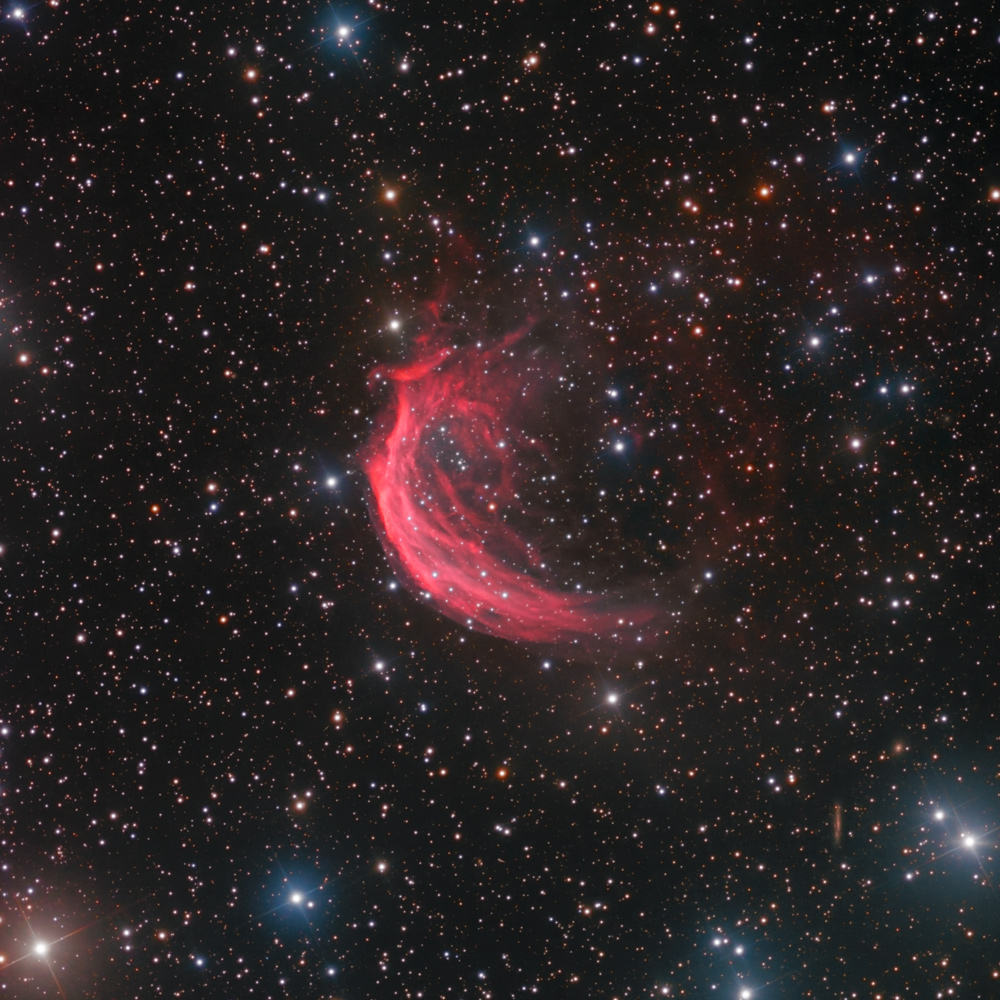

Sh2-188, is a planetary nebula,
the type of nebula which it is generally thought our Sun will produce as nuclear fusion slows and then dies in its core, and it expels its outer layers of gas. It is quite close to us (in cosmic
terms) at a distance of about 850 light years; at that distance, it is about 2.3 light years across. Technical Information: Ha:OIII:L:R:G:B: 660:570:495:240:240:300 (a total of almost 37 hours of light-frame exposure time); luminance was a blend of thirty-three 15-minute images through a luminance filter,
and twenty-two 30-minute images through an Ha filter; red was a blend of sixteen 15-minute images though a red-pass filter, and twenty-two 30-minute images through an Ha filter; green was a blend of sixteen
15-minute images through a green-pass filter and nineteen 30-minute images through an OIII filter; blue was a blend of fifteen 20-minute images through a blue pass filter and the OIII data also used in the green channel. Equipment: RC Optical Systems 14.5 inch Ritchey-Chretien carbon fiber truss telescope, with ion-milled optics and RCOS field flattener, at about f/9, and an SBIG STX-16803 camera with
internal filter wheel (SBIG filter set), guided by an SBIG AO-X, all riding on a Bisque Paramount ME German Equatorial Mount. Image Acquisition/Camera Control: Maxim DL, controlled with ACP Expert/Scheduler, working in concert with TheSkyX. Processing: All images calibrated (darks, bias and sky flats), aligned, combined and cropped in Pixinsight. Color combine in Pixinsight. Histogram stretch in Pixinsight using Generalised
Hyperbolic Stretch. Some finish work (background neutralization, color calibration, combining narrow-band and broadband data, some sharpening, deconvolution with BlurXterminator, and noise reduction with Noise Xterminator)
done in Pixinsight; some cleanup finish work was done in Photoshop CC. Location: Data acquired remotely from Sierra Remote Observatories, Auberry, California, USA. Date: Images taken on many nights in November and December of 2022. Image posted June 7, 2023. Date: Image scale of full-resolution image: 0.56 arcseconds per pixel. Seeing: Generally good CCD Chip temperature: -25C Copyright 2022, 2023
Mark de Regt
The reddish parts of the nebula represent ionized hydrogen; there is some doubly-ionized oxygen, but little compared to the hydrogen, so all it does is give a bluish tint to
some of the red.
This planetary nebula is asymmetrical, which is not usual for planetary nebulae. The reason for that is that the nebula and its central star are moving through local space (relative to the rest of the
things there) at a very high speed, which causes a "bow shock wave," making the leading edge (the left side; the brighter part in this image) much brighter than the trailing part. If you look closely,
you can see that there is a "trailing part" (faint red glow completing the "ball" shape of the nebula) but it's much dimmer than the leading edge. The central/progenitor star is the small, bright blue
star above and to the left of the bright yellow/red star at the right edge of the brighter part of the nebula (about half way down the nebula).
As always, I enjoy seeing small (meaning very distant) background galaxies in the image. In particular, there are two 45 degrees below and to the right of the nebula; the edge-on spiral galaxy is
PGC 137850, while the elliptical galaxy is PGC 137845. I could not find how far away these two are, but they are at least several hundred million light years away; those are some determined photons
that got all the way to my telescope!